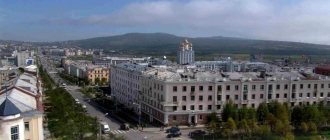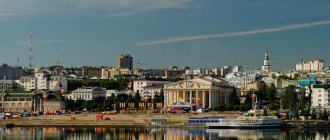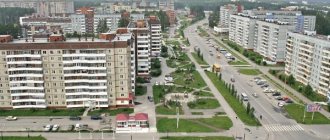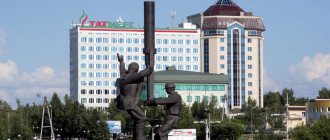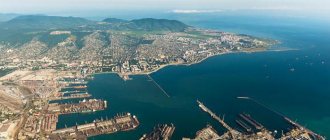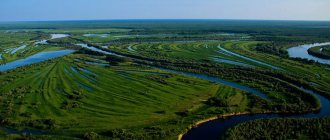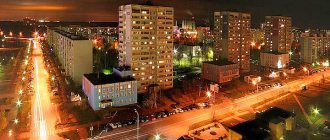The famous Russian Saint Seraphim received his nickname of Sarov from the locality where his spiritual formation took place in a local monastery. Nowadays the city of Sarov, where you can see a lot of interesting things, belongs to the Nizhny Novgorod region. A sacred place for Orthodox believers in the 20th century acquired completely different associations. The settlement became a center of nuclear development and received the status of a closed city. For some time it bore the names Kremlev and Arzamas-16. In 1995, the historical name returned. Tourist trips to Sarov are possible, but for this you need to order a pass in advance. It’s worth it, because behind the rows of barbed wire are hidden various attractions that introduce you to the glorious past of the settlement.
Sarov on the map of Russia
The closed administrative-territorial entity “city of Sarov” is located on the border of two constituent entities of the Russian Federation - the Nizhny Novgorod region and the Republic of Mordovia. Although administratively it belongs to the Nizhny Novgorod region. The founding date of the closed city is considered to be 1954. Although the history of the settlement itself dates back to the end of the 17th century.
In Soviet times, this settlement had several code names: “Base No. 112”, “Gorky-130”, “Arzamas-16”. Sarov is a toponym derived from the Finno-Ugric word “sara”, which translates as “swamp” or “swamp”. It is worth noting that it is quite common in the toponymy of Mordovia and neighboring regions.
How long is it from Sarov to Nizhny Novgorod in kilometers? The closed city is located 200 kilometers south of the regional center. The journey between these two cities takes about three and a half hours.
Natural monuments
Sarov has magnificent unique natural monuments, which in 1999 received regional significance. In a deep mixed forest, in a round clearing overgrown with grass, there is the Holy Tract of Keremet - a cult place of Finno-Ugric tribes. On the bank of Satis in a deciduous forest is another attraction of Sarov - eight cold, pleasant taste and low mineralization, pure springs called Silver Keys. The natural urban landscape near the monastery includes a local natural monument in the Satis floodplain - the Flood Meadow, densely overgrown with herbs and primroses. The Sysovsky cordon and Filippovka tracts, surrounded by mixed forests and ponds formed by monks on the streams flowing here for timber rafting, are of water conservation and historical importance. The monastery ponds Varlamovsky, Protyazhka and Shilokshansky pond, visited by tourists and pilgrims, were used for the same purpose.
Sarov: history of the city
Sarov arose in 1691, when a monk named Theodosius from Penza settled on a hill above the local Sarovka river. A little later, monk Isaac settled in the same place and founded a monastery here. We will talk about the Sarov Desert in more detail in our article. Now let us just mention that the Monk Seraphim of Sarov, one of the most revered saints of the Russian Orthodox Church, lived in this monastery.
For a long time, Sarov remained a small town and a place of pilgrimage for many believers. But everything changed dramatically after World War II. It was in Sarov that experimental work on the development of nuclear weapons began in 1947. Here, two years later, the first atomic bomb of the Soviet Union was created. Its double can still be seen today in the city Museum of Nuclear Weapons.
Why Sarov is a closed city is not difficult to guess. The Russian Federal Nuclear Center (RFNC-VNIIEF) operates here today, producing nuclear weapons. This is the main and city-forming enterprise of Sarov.
Sarov Desert
For some time before the Russian monks came here, the settlement remained desolate, surrounded by dense forests and clean springs. The first desert dweller was the monk Theodosius in 1664, who heard the wonderful church bells ringing here from underground and saw the extraordinary radiance of the hill at the site of the ancient settlement.
The organizer of the Sarov Hermitage in 1705 is considered to be Hieroschemamonk Isaac, who came from Arzamas and received the land of the settlement from Daniil Ivanovich Kugushev, a baptized Tatar prince. The following year, in 50 days, a wooden church was built here in honor of the Most Holy Theotokos - the first church of the monastery. Having learned about the monastery, monks began to arrive and build cave dwellings around the church - cells in the mountain.
How to get to Sarov?
During Soviet times, the city, having a fairly large number of residents and well-developed infrastructure, was not marked on any public map. Today, the strict secrecy regime has been lifted from Sarov, however, it still remains closed to outsiders. The Google map shows the city itself, but the access roads to it are hidden.
It is incredibly difficult for a person without local registration to get to Sarov. The city is literally surrounded by barbed wire and is reliably guarded. The access regime in the “nuclear heart of the country” is very strict; an application for a visit must be submitted two to three months before the intended trip. And even then it’s not a fact that you will receive entry permission. To do this you need to be a close relative of one of the local residents. Another way to get to Sarov is for work or study. But there are no guarantees here either.
Tourists and mere mortals are prohibited from entering the city. The only option is to book a pilgrimage tour to the Seraphim places. In this case, the excursion bus will be thoroughly inspected, and the tourist group in Sarov will be accompanied by a “special officer”.
If you have an entry permit in your hands, you can get to Sarov in three ways:
- In your personal car.
- By regular public transport (buses and minibuses regularly depart from the Nizhny Novgorod bus station to Sarov).
- By train (a passenger train departs from the Kazansky railway station in Moscow daily at 20:48; it arrives in Sarov at 7:00 am the next day).
Sculptural monuments
Guests of the city who have had the opportunity to visit it are convinced that everyone who visits this place must see the sights and monuments in Sarov associated with the rich history of the city and the spiritual revival of the country.
The monument to Seraphim of Sarov, designed by V. M. Klykov, the author of the monument to G. K. Zhukov in Moscow, was erected in 1991 in the forest on Dalnaya Pustynka, 5 km from the monastery where the elder lived and prayed. In this place, on the elevated bank of the Sarovka River, the monk built a small wooden cell, planted a vegetable garden, and dug a cave in the hillock. According to legend, a bear came out of the virgin forest here and was hand-fed by Seraphim. Sarov residents celebrate Orthodox holidays here. Near the monument there is a large pine tree of the reverend elder, which you need to hug and make a wish. All excursions around Sarov start from here.
The monument to architect N.V. Kuznetsov and the Victory Square with the eternal flame have existed in the city since the 1960s. and are dedicated to the memory of three hundred Sarov residents who died and disappeared during the Great Patriotic War. On the alley of the square there is also a monument to soldiers who served in hot spots, erected using public funds - a sculpture of a soldier sitting after a battle (author M. M. Limonov).
Nikolai Vasilyevich Kuznetsov, a talented painter and chief architect of Sarov, was the author of projects for creating public gardens, boulevards, parks, a hospital town and a suspension bridge over the Satis in the city - a favorite place for newlyweds since 1964. He was also the author of pedestals for the monuments to V. I. Lenin on main square (design by S. O. Makhtin) and A. M. Gorky at the Palace of Creativity (works by P. V. Koenig).
The monument to the outstanding nuclear physicist, founder of the city Yu. B. Khariton was installed in the park near the House of Scientists in 2004. The author is the rector of the St. Petersburg Art Academy A. S. Charkin. In the theater square in 2010, a bronze bust was unveiled to the director of Uralmash, and later to the director of Sarov KB-11, B. G. Muzrukov, the author is the Ural sculptor K. Grunberg.
A 1986 monument in the style of Soviet realism by local architect G.I. Yastrebov is dedicated to the builders of the city; it is located at the intersection of Chapaev and Silkin streets.
Population of Sarov: in numbers and graphs
Today, about 95 thousand people live in the science city. Moreover, over the past thirty years, the population of Sarov has been growing steadily and steadily (see graph below).
If at the beginning of the twentieth century no more than two thousand people lived in the city, then by the beginning of this century this figure increased to 85 thousand. In terms of population, Sarov ranks 181st in the country (as of January 1, 2022). According to demographers, the city will reach 100 thousand inhabitants.
Since approximately the mid-2000s, the Sarov registry office has recorded a continuous increase in the birth rate. The mortality rate, on the contrary, has been declining since 2013. The migration growth curve is unstable from year to year.
The main cause of mortality, as in many other cities and regions of Russia, remains diseases of the circulatory system (in particular, heart disease). In second place are neoplasms, and only in third place are injuries and accidents.
Other demographic figures and indicators for the city of Sarov (for 2015):
- The number of abortions per year is 468.
- The number of marriages is 530.
- The number of divorces is 401.
- The share of the economically active population of Sarov is 49.4%.
Reasons for closure
In 1927, the monastery ceased to exist, and on its territory the Labor Commune of the NKT (People's Commissariat of Labor) factory was located, where street children worked. The labor commune was more of an educational nature, where through labor they tried to re-educate young tramps, most of whom had already engaged in robbery and theft in the past. The total number of children living and working in the commune by 1931 was about 3.5 thousand.
After 1931, the Labor Commune was liquidated, and in its place a colony for NKVD prisoners was formed, which existed until 1938.
In November 1938, it was decided to establish the production of pressing equipment and high-explosive fragmentation shells of 152 mm caliber on the site of the former colony. And during the Great Patriotic War with Nazi Germany in the period from 1942-1943. here they manufactured shell casings for the world-famous Russian Katyusha rocket mortars. The plant was assigned the number 550, and according to statistics, every fifth shell fired at the enemy was manufactured at Sarov Plant No. 550.
After the war in 1946, a significant event took place for Sarov. It was decided to establish a secret facility for the creation of nuclear weapons on the territory of the city. From this moment on, Sarov becomes not just a closed city, but a secret object with the code name “Settlement KB-11” and disappears for a long time from all maps of the country.
Over the course of several years, for purposes of secrecy, its names have been constantly changing: KB-11, Moscow Center 300, Kremlev, Arzamas-75. Arzamas-16, Gorky 130. The best scientists, technicians and workers of the country were involved in the creation of nuclear weapons under the leadership of Soviet physicists Yu. B. Kharitonov and I. V. Kurchatov. All information about their work was hidden for many years.
By the way, there was a slight embarrassment with the name Arzamas -75. The fact is that the distance of the road from Arzamas-75 to the city of Arzamas was 75 kilometers, which coincided with the number in the code name. They say that this figure was chosen completely by chance.
But it is clear that for a secret object such coincidences are fraught, so another name was soon chosen, Arzamas-16. The city received its last name from the Sarovka River flowing through its territory.
ZATO Sarov: interesting facts and urban myths
The two most popular myths about Sarov:
1. Increased levels of radiation. In fact, background radiation within the city does not exceed permissible standards. You won't find two-headed ravens or other mutants here. And objects don’t glow at night, no matter how much someone might want it to.
2. Sarov risks falling underground. Under the city there really is a fairly large pool of artesian, crystal clear and fresh water. However, the legend that Sarov can go underground at any moment is far-fetched and stupid.
Below we bring to your attention a few more interesting facts about this city:
- The architecture of Sarov is quite diverse. Here you can find ordinary Khrushchev buildings, magnificent Stalin buildings, and modern town houses.
- The city was built up in waves as VNIIEF received new government orders.
- At one time, it was here that the outstanding scientist A.D. Sakharov worked.
- The standard of living and salaries in Sarov are significantly higher than the regional average. At the same time, the cost of square meters here is almost equal to Moscow prices.
- Sarov is an incredibly green city, because it was built, essentially, in the middle of a dense Mordovian forest.
- Bus stops in Sarov are themed. For example, on the walls of the bus stop pavilion near the city library you can see portraits of famous poets and writers.
- The city has a developed sport such as ice hockey. The local club Sarov competes in the Russian Major Hockey League.
Famous townspeople
- Sakharov, Andrei Nikolaevich - physicist and political figure, Nobel Peace Prize laureate for 1975.
- Khariton, Yuliy Borisovich - theoretical physicist and physical chemist, three times Hero of Socialist Labor.
- Kocharyants, Samvel Grigorievich - designer of thermonuclear weapons, twice Hero of Socialist Labor.
- Muzrukov, Boris Glebovich - business manager, twice Hero of Socialist Labor.
- Negin, Evgeniy Arkadyevich - scientist, academician of the Russian Academy of Sciences, Hero of Socialist Labor.
- Trutnev, Yuri Alekseevich - Soviet and Russian physicist, academician of the Russian Academy of Sciences, Hero of Socialist Labor.
- Firova, Tatyana Pavlovna - Russian track and field athlete.
- Taktarov, Oleg Nikolaevich - Russian actor, athlete who performed in mixed martial arts
- Sorokko, Tatyana Nikolaevna] - the first Russian supermodel
- Sedov, Nikolai Evgenievich - coach of the Russian youth cross-country team, senior coach of the Russian women's team 2010-2011.
- Sedov, Pyotr Nikolaevich - member of the Russian cross-country skiing team, five-time world champion among juniors, master of sports.
- Khazova, Irina Viktorovna - member of the Russian cross-country skiing team, bronze medalist of the Vancouver Olympics, Honored Master of Sports of Russia.
Main attractions of Sarov
There are nine natural monuments in the city and its immediate surroundings. These are primarily springs with healing water, ponds and tracts. Sarov is also rich in historical and cultural monuments. Among the most popular and visited attractions of Sarov are the following objects:
- Holy Dormition Sarov Hermitage (a complex of buildings of the 18th-19th centuries).
- Monument to Seraphim of Sarov.
- Nuclear Weapons Museum.
- Administrative building of RFNC-VNIIEF.
- Museum of History and Local Lore.
- Natural monument “Silver Keys”.
- Sarov Drama Theater.
- Monument to the City Builders.
- Monument "Telephone Booth".
- The house with the spire is a masterpiece of Stalinist classicism.
Seraphim of Sarov
The hermitage was glorified by the great elder, revered in the Christian world, Saint Seraphim of Sarov, who came here as a youth from Kursk in 1776, who dedicated his life to sincere prayers and helping the suffering. His biography was compiled by the local hieromonk Sergius; the icons of the miracle worker were painted from a portrait drawn by the artist Semyon Serebryakov. St. Seraphim was canonized in 1903 in the Sarov Hermitage in the presence of Emperor Nicholas II. Gradually, the appearance of the monastery changed, new stone churches were built, and pilgrims from all over Russia sought to visit the shrine. In the 1920s The monastery was closed, the elder’s relics disappeared for many years and were miraculously found again in St. Petersburg in 1991.
